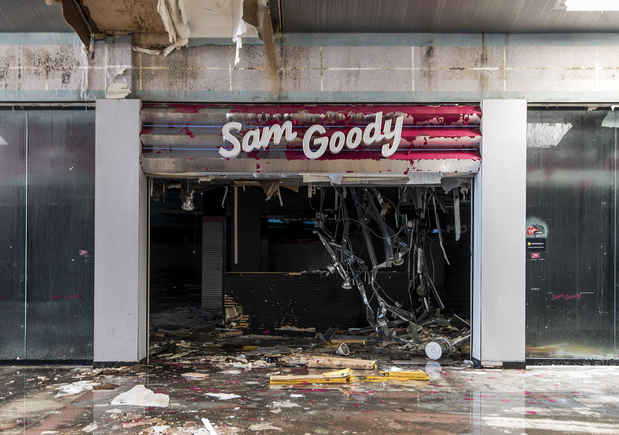Phillip Buehler “Mallrat to Snapchat: The End of the Third Place”
Front Room Gallery

This event has ended.
Front Room Gallery presents “Mallrat to Snapchat: The End of the Third Place,” recent work by photographer Phil Buehler documenting a dead mall in Wayne, New Jersey. This is Buehler’s second solo show at Front Room.
Malls all across America are closing, and along with them the culture they inspired. With Amazon, online music, digital books, streaming video, Facebook and Instagram, people have less and less reason to leave their homes and meet people face-to-face. Once a center of American culture, malls were so popular that they were even the setting for movies such as “Fast Times at Ridgemont High” and “Dawn of the Dead” and more recently with the Netflix series, “Stranger Things.”
Buehler thinks of himself as a sort of time traveler, venturing to abandoned places to bring back remnants of their endangered history. The Wayne Hills Mall is one such place, and Buehler snuck in many times before it was finally torn down earlier this year. All that’s left is a large pile of concrete. On labels next to his photographs in the exhibition will appear the dates each store closed or declared bankruptcy – Sam Goody, Waldenbooks, Toys R Us and many others.
The Death of Mall Culture
Between 1970 and 2010, the number of American shopping malls quadrupled. In that time span, they became de-facto social space for America’s suburban youth. Buehler is a Baby Boomer and grew up in a working class town in New Jersey. He received his driver’s license in 1973, the year Wayne Hills Mall opened. It was the golden era of the shopping mall. While the mall was the main social meeting ground in the past, mall based chain stores have been on the decline in recent years. The loss of larger anchor stores and changes in the retail climate have led to the slow death of indoor shopping malls in America.
The Mall as a “Third Place”
The subtitle of the exhibit is, “End of the Third Place,” a nod to a term coined by urban sociologist Ray Oldenburg in 1989. It refers to places where people spend time between home (“first” place) and work (“second” place). They are places where we exchange ideas, have a good time, and build relationships. In his influential book, “The Good Place,” Oldenburg explains why these places are essential to community and public life- arguing that bars, coffee shops, general stores, shopping malls and other “third places” strengthen community vitality. One is left to wonder if Snapchat and other social media can play the same role.
Opening in 1973, the year of Impeachment hearings and more…
Wayne Hills Mall opened in October of 1973, and looking back we can see how history runs in cycles. That year, the House of Representatives opened impeachment hearings on President Nixon, which resulted in his resigning his office less the following summer. It was a year full of landmarks: the Endangered Species Act was signed – which Trump is now trying to roll back – Roe v. Wade was decided by the Supreme Court – also in danger as Trump stacks the Supreme Court. There was instability in the Middle East, and the Yom Kippur War led to the Arab oil embargo, which in turn led to a tripling of oil prices and gasoline rationing. The Paris Peace Accords were signed, officially ending the Vietnam War. Homosexuality was removed from the list of mental disorders. And the World Trade Center opened.
An installation of vinyl albums from 1973
Under a photograph of the abandoned Sam Goody will be record bin full of LPs from 1973. Gallery visitors will be able to flip through a hundred albums from that year, pick one out and play it on a vintage record player. The number one album on the Billboard chart that year was Elton John’s “Goodbye Yellow Brick Road,” followed by “Pink Floyd’s Dark Side of the Moon.” The Beatles released two greatest hits albums while George, Paul, John and Ringo released solo albums. And Bruce Springsteen had two on Rolling Stone Magazines top album list, “Greetings from Asbury Park” and “The Wild, the Innocent and the E Street Shuffle.”
About Phil Buehler
Phil Buehler grew up in a nearby town in New Jersey, and his adventures exploring and photographing began in 1973, the same year the mall opened. But he had to wait another 45 years to photograph its demise.
Phil Buehler’s interest in Modern Ruins began in 1973, when he rowed out to then-abandoned Ellis Island, and he has continued to document 20th-Century ruins around the world, seeking to rescue important remnants of the past, frequently just one step ahead of the wrecking ball. His recent book, “Woody Guthrie’s Wardy Forty,” won numerous awards and documents the singer/songwriter/activist’s life at Greystone Park Psychiatric through an intricate juxtaposition of photographs of the now-abandoned hospital buildings, Guthrie’s writings, medical records and interviews with close friends and family.
Media
Schedule
from November 27, 2019 to January 12, 2020
Closing Reception on 2020-01-12 from 16:00 to 18:00